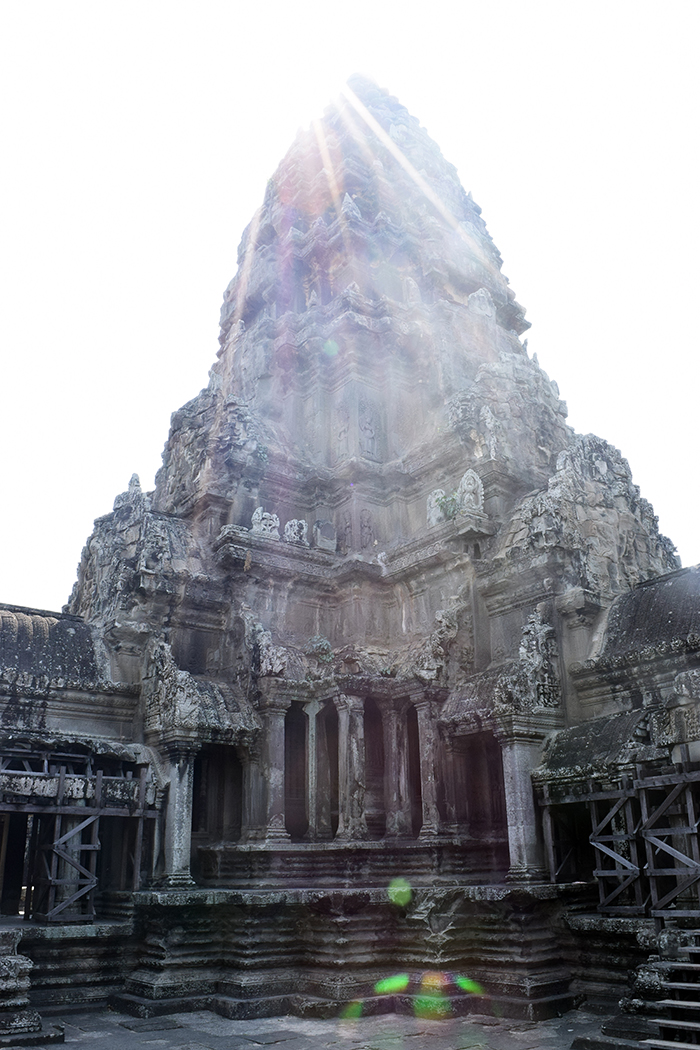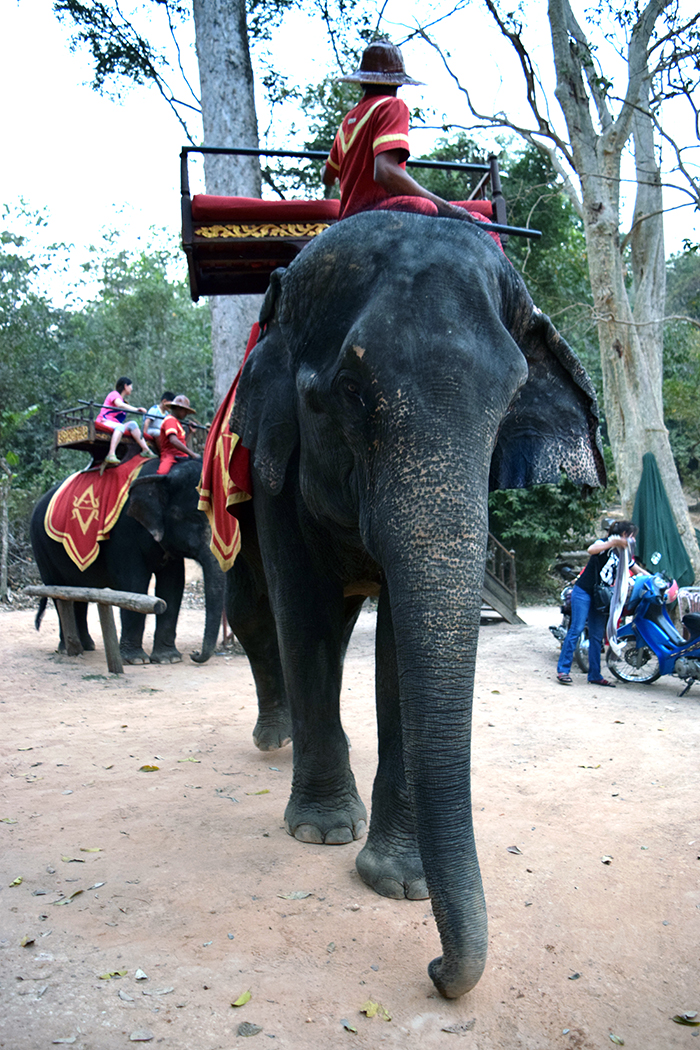



























































Today was temple day, a necessity for all who pass through Siem Reap and its UNESCO world heritage site, Angkor Wat. Even though it was scorching outside, I threw on a baggy t-shirt, long pants, thick socks, and my Converses. I had read online that both men and women needed to cover up all the skin between their shoulders and their knees to access several temples, and I wasn’t going to take any chances. My camera battery was fully charged and I was ready to catch some legendary scenes among the ruins.
Of course, it was also already 1PM by the time my friends and I were finished with breakfast and ready to go. We only had time for the short temple route, which would take us through the four most popular temples across the massive region of Angkor. The sky was empty of clouds and the dust was easily disturbed under my feet, roiling at the barest of movements, surrounding me in a soft haze that followed me everywhere, coating my hair and skin in a light layer of grime.
It was a bumpy, throat-parching, gritty ride via tuk tuk to the temples. The sites are just outside of the main city, but the distance between each separate temple is too far to walk. Our driver was friendly and knew all the spots that tourists would want to check out. He handed each of us his business cards, on which he’d titled himself “Rithy, English Speaking Tuk Tuk Driver.” The laminated cards were charming and Rithy was happy to answer our questions about Buddhist traditions, ancient Hindu sculptures, and the city. (Sidenote: if you’re ever looking for a tuk tuk in Siem Reap, message me and I’ll send you his phone number.)
As we pulled up to the crumbling stone labyrinth of the largest and most famous temple, Angkor Wat, I could feel its power, even over a thousand years after the Khmer Empire’s downfall and the sanctuary’s abandonment. I hopped out of the tuk tuk, instinctively unzipping my backpack and pulling out my camera. Though a million photos had already been taken of this place, I couldn’t help but want my own, if only to look at later as a reminder to myself of how incredible this monument was both as an observation of an ancient culture and as a symbol of the human capacity to create.
We crossed a manmade moat wider than twice the length of a football field to reach the temple site. That body of water alone was a masterpiece; how many thousands of men did it take to dig it out? How many decades? The builders of Angkor Wat had erected a massive stone bridge over it, the only walkway between the temple and the mainland. Each gray brick was at least a couple feet wide and five feet long. How many men did it take to carry a single brick?
Once I wandered through the main entrance, a long, slender hall of small rooms, I faced an even longer stone walkway that was flanked on both sides by wide, green fields. Manmade, perfectly-square lily pad ponds were dug into each half and the landscape was sprinkled with tall, thin, curved palm trees that stood out strangely from their dry, flat surroundings. At the other end of the walkway was the main temple, a huge, square, two-story maze decorated with wide, hat-like spires. Tourists wandered everywhere, dotting the gray and green landscape with t-shirts and baseball caps and temple pants of all the colors of the rainbow.
Every millimeter of every stone in this temple complex had been etched with ornate carvings - and much of it was still in decent shape for the amount of time that had passed and the number of tourists that visit it on a daily basis. There were sculptures of topless women wearing crowns of snakes emerging from walls and intricate, fifty-feet long scenes of hundreds of soldiers with lion-like features destroying their enemies in battle. I was particularly fond of one mural whose paint hadn’t completely faded yet; the face of the warrior still held a rusty red hue, his blood angrily spilling onto his adversary as he choked him to death with bare hands. There were too many illustrations on every surface for me to take it all in; most of the ceiling was even carved! I could visit that complex a hundred days in a row and still find images hidden in the stones between impressions of flowers and designs that spanned for hundreds of meters.
I was surprised by the lack of supervision. And let me note, I wasn’t disappointed. It was liberating to clamber about the temple grounds without feeling the critical gaze of a black-suited mall-cop-esque figure watching me. There were no time limits on how long I could stare at a single carving, no red ropes, no one to stop me from frolicking in the fields, reveling in my stupendous surroundings. It also meant that climbing up some of the particularly steep and slender staircases held more than just a hint of adventure. My inner Indiana Jones adored it. My friend Liam is a bit of a parkour fanatic and entertained many large crowds of Japanese tourists with his front flips down staircases, hand stands, and run-up-and-flips off palm trees. I know that there are very serious and realistic reasons that most Western countries won’t let this amount of freedom fly in national monuments and around important artifacts, but it was an awesome experience to have my own little escapade through the temples.
As incredible as Angkor Wat was, my favorite site was Prasat Bayon, a temple at the center of Angkor Thom, the last constructed and longest-lasting capital of the Khmer Empire before it too was abandoned sometime before 1609. It’s about a five to ten minute tuk tuk ride away from Angkor Wat, past the monkey-infested jungle and over a bridge guarded by seven-foot tall statues of warriors serving as balustrades for the heavy stone railing on either side. When we approached Prasat Bayon and the imagery on all sides of the tall, dense structure became clear, I was speechless. As we wandered past a large tour group, I heard the guide telling awe-struck, open-mouthed tourists that “bayon" means magic in Khmer. And this breathtaking place is magical in the deepest, most spellbinding sense. The hundreds of six-foot-tall carved faces covering each pillar of the temple follow you as you walk. But it’s not creepy even in the smallest sense; it’s staggering to see. The statues’ lips are slightly curled up, giving an air of sneering, fathomless wisdom to their expressions, and the smiling eyes hold mysteries and secrets of a forgotten time in an ancient place.
The last stop on the temple tour was to a relatively unspectacular temple (I say that in the basest sense - it was mediocre compared to Angkor Wat, but still a remarkable structure in itself) that Rithy told us had “the best view of the sunset” in the complex. However, hundreds of people were lined up in front to watch the sun go down over the jungle. We waited in line about forty-five minutes to climb to the top and when we made it, we found out that Siem Rep doesn’t even really have sunsets. The sky was as dusty as the streets, hanging a heavy, murky gray-blue over the land. And in the middle of it sat a tiny, neon, fruit-punch-red sun. People shoved forward for a better view (not that there was one; it was impossible to get any photos without at least a couple elbows in frame). It was a little bit disappointing as an ending, but overall, the trip was out of this world.
Expenses:
- $6 tuk tuk (price per person)
- $20 Angkor Wat daily entrance fee
- $1 Water Bottles (lots of them)